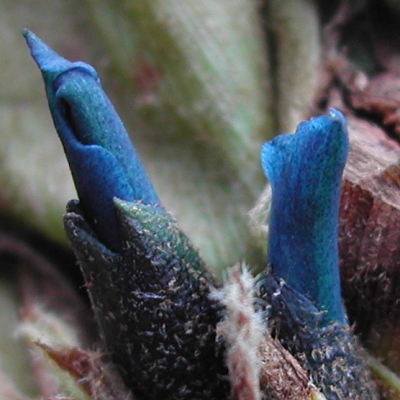| Home |
Strange Wonderful Things Rare and exotic plants |
 |
|---|
Puya dasylirioides
Germinating the seeds
Getting started -- You may start the seeds in small pots or cups that have holes at the bottom. For soil, i recommend a mix of 1 part high-quality potting soil and 1 part perlite, mixed well. Do not add lime to the soil, as this species prefers slightly acid conditions.
Fill each container almost to the top with your soil mix, then water it so it is uniformly moist. Place a seed on top, and sprinkle a very thin layer of soil on top - just enough to barely cover the seeds, because the seeds need light to germinate. Moisten the top layer of soil carefully.
Ensure that the surface soil does not dry out. To maintain moisture, you may put the pots in a propagation dome or plastic bag that's kept open a crack for ventilation. Place the pots in an area that is about 65-75 degrees F (18-24°C). I recommend keeping the soil below 80° F (27°C). If you use a heat mat, check the soil temperature to ensure that it doesn't overheat. For lighting, you may use a fluorescent bulb kept a few inches (10 cm) away, or give them well-filtered sunlight.
The seeds will begin sprouting at 4-6 weeks, and can continue for another 2 months. Once they sprout, open the bag or dome a little more, to avoid rot. Water the soil whenever the soil surface dries out. Avoid keeping the leaves wet for long periods of time. Aim to keep the soil lightly moist throughout, but not soggy. By the way, if your tap water is very alkaline or "hard", i recommend using rainwater or bottled water.
Lighting -- Give your seedlings bright light, such as morning sun, or a fluorescent bulb kept a few inches away. Protect from strong afternoon sun. After 5-6 months, they should be given a few hours of strong lighting (either sunlight or high-intensity lamps), and gradually increase the light exposure. Once they are a year old, they should be ready for full sun, except in warm climates, where they should receive some protection from strong afternoon sun.
Long-term care -- For the first year, keep the soil evenly moist (but not soggy). After that, begin letting the soil dry out more, but don't let it get bone-dry. Every 2-3 months, give it a deep watering so the soil is drenched.
Fertilizing -- Most potting soil contains some fertilizer, and if yours does, your seedlings shouldn't need feeding for the first 2-3 weeks. After that, feed every 4-6 weeks using an all-purpose fertilizer at 1/4 the recommended dose. Every third feeding, use a fertilizer for acid-loving plants. Remember that small seedlings don't need much fertilizer, so be careful not to overfeed.
Transplanting -- When your plants are as wide as the container they are in is tall, repot them to larger containers. Use a tall pot that is larger than average, as the roots can be extensive. Water the soil before repotting to keep the soil ball from breaking apart. If the soil does break apart, give bright shade the first few weeks, then increase the sun gradually.
Temperature/humidity -- Protect your plants from frost the first 2 years. Adults plants are reportedly hardy down to at least 19° F (-7°C), but they probably will bloom the soonest if protected from hard frosts. During the summer, give them some afternoon shade in warmer climates. Over about 40% humidity is recommended.
Let me know if you have questions.
Jeff
Strange Wonderful Things
| Home |
Strange Wonderful Things Rare and exotic plants |
|
|---|---|---|
| Entire site Copyright 2003-2025 by Strange Wonderful Things, except as noted | ||

